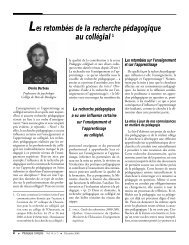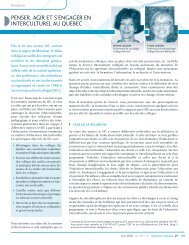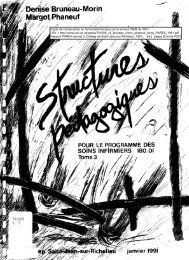En quête d'une éthique de la relation éducative chez l ... - CDC
En quête d'une éthique de la relation éducative chez l ... - CDC
En quête d'une éthique de la relation éducative chez l ... - CDC
You also want an ePaper? Increase the reach of your titles
YUMPU automatically turns print PDFs into web optimized ePapers that Google loves.
1.1.2 La distance maintenue entre les acteurs ..................................................... 199<br />
1.1.3 Les signes non verbaux ............................................................................. 201<br />
1.1.4 La gestion <strong>de</strong> <strong>la</strong> c<strong>la</strong>sse ............................................................................... 202<br />
1.1.5 Le ren<strong>de</strong>ment sco<strong>la</strong>ire ............................................................................... 204<br />
1.2 Une posture <strong>de</strong> performance intellectuelle ................................................. 207<br />
1.2.1 La re<strong>la</strong>tion à l’autre ................................................................................... 209<br />
1.2.2 La gestion <strong>de</strong> <strong>la</strong> c<strong>la</strong>sse ............................................................................... 213<br />
1.2.3 Le ren<strong>de</strong>ment sco<strong>la</strong>ire ............................................................................... 214<br />
1.3 Une posture <strong>de</strong> partenariat......................................................................... 216<br />
1.3.1 L’uniformisation <strong>de</strong> l’enseignement, pourquoi donc?................................. 218<br />
1.3.2 La gestion <strong>de</strong> <strong>la</strong> c<strong>la</strong>sse ............................................................................... 219<br />
1.3.3 Une acceptation <strong>de</strong>s différences................................................................. 219<br />
1.3.4 Le p<strong>la</strong>isir d’apprendre ............................................................................... 222<br />
2. La parole aux étudiants .......................................................................................... 227<br />
2.1 La perception <strong>de</strong>s étudiants sur l’apport <strong>de</strong> <strong>la</strong> re<strong>la</strong>tion <strong>éducative</strong> ................ 228<br />
2.2 Des caractéristiques appréciées <strong>chez</strong> l’enseignant ...................................... 232<br />
2.3 Une contribution attendue dans <strong>la</strong> scène <strong>éducative</strong>..................................... 236<br />
SIXIÈME CHAPITRE – LA DISCUSSION SUR LES RÉSULTATS<br />
DES ENSEIGNANTS ET DES ÉTUDIANTS................................................................. 239<br />
1. La discussion sur les résultats <strong>de</strong>s étudiants............................................................ 239<br />
1.1 L’urgence <strong>de</strong> montrer «t’es qui toi là-<strong>de</strong>dans» ........................................... 240<br />
1.2 Une vulnérabilité existentielle <strong>chez</strong> les post-adolescents............................ 242<br />
1.3 Devenir acteur et auteur <strong>de</strong> ses apprentissages ........................................... 248<br />
2. La discussion sur les résultats concernant les enseignants....................................... 250<br />
2.1 <strong>En</strong> route ensemble vers <strong>la</strong> profession ......................................................... 251<br />
2.2 Un modèle opératoire <strong>de</strong> l’acte d’enseigner et d’apprendre ........................ 255<br />
2.3 Une <strong>éthique</strong> <strong>de</strong> <strong>la</strong> re<strong>la</strong>tion <strong>éducative</strong> .......................................................... 258<br />
3. Retour à <strong>la</strong> question <strong>de</strong> recherche........................................................................... 265<br />
3.1 L’intention <strong>éducative</strong> <strong>de</strong>vance et agit en <strong>de</strong>çà <strong>de</strong> l’action ........................... 265<br />
3.2 La fonction instrumentale subordonnée à <strong>la</strong> fonction symbolique............... 266<br />
3.3 Devenir acteur et auteur <strong>de</strong> ses apprentissages ........................................... 269<br />
3.4 Un intérêt commun d’apprendre <strong>de</strong> l’autre et par l’autre ............................ 270<br />
3.5 Une <strong>éthique</strong> <strong>de</strong> <strong>la</strong> re<strong>la</strong>tion <strong>éducative</strong> .......................................................... 272<br />
CONCLUSION............................................................................................................... 277<br />
1. Les limites <strong>de</strong> <strong>la</strong> recherche ..................................................................................... 278<br />
2. La contribution <strong>de</strong> <strong>la</strong> recherche .............................................................................. 279<br />
3. Les pistes <strong>de</strong> recherche .......................................................................................... 281<br />
RÉFÉRENCES ............................................................................................................... 283<br />
viii





